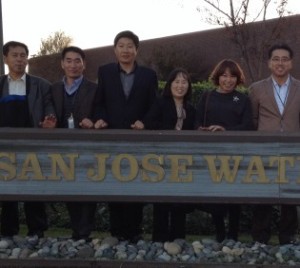California Water Association (CWA) hosted the California Urban Water Conservation Council’s Plenary (CUWCC) meeting on September 18 in Downey.
Speaking on behalf of the investor-owned water companies (IOWCs) that are regulated by the California Public Utilities Commission (CPUC), CWA Executive Director Jack Hawks explained the IOWCs serve nearly 6 million Californians. He noted that the 10 largest IOWCs have signed CUWCC’s Memorandum of Understanding (MOU), which commits all signatories to compliance with a series of water use efficiency Best Management Practices (BMPs). Signatories to the MOU recognize California’s economy, quality of life and environment depend, in large part, upon the state’s water resources. They also recognize the need to provide reliable urban water supplies while protecting the environment. Their adherence to the MOU’s BMPs is reviewed by the CPUC every three years in each company’s general rate case.
California Water Service Company Conservation Manager Ken Jenkins continued the presentation with a breakdown of each company’s supply sources from groundwater, purchased water, surface water and recycled water as well as usage by various customer types. After explaining the companies’ conservation rate structures, Jenkins gave an update on the water companies’ progress on compliance with the 2009 state law that targets a 20 percent reduction in per capita water consumption by 2020. Like many water agencies, the IOWCs’ focus has been on traditional tools that save water inside (toilets, showerheads, toolkits, etc.) and outdoors (landscape audits, smart controller retrofit programs, landscape classes and materials, etc.).
Tiffany Tran, conservation coordinator at San Gabriel Valley Water Company and chair of CWA’s Water Conservation Committee, closed the CWA presentation with an overview on the regulated water utilities’ water use efficiency programs. A few examples of CWA member companies’ conservation programs include Apply Valley Ranchos Water Company’s “Cash for Grass” incentive program, California Water Service Company’s commercial landscape incentive program, San Jose Water Company’s recycled water program, Suburban Water Systems’ National Theatre for Children program and Park Water Company’s demonstration garden and well site drought-tolerant retrofit.
According to Tran, IOWCs are continuing to look for innovative products, services and ideas that will encourage customers to use water even more efficiently. Some of these include incentive conservation rates, tiered rebates, more sophisticated water management/billing tools for customers and utility financing hardware retrofits for customers. IOWCs may also expand rebate/incentive offerings for customers who use graywater plumbing kits, pressure regulation, rain barrels, flow sensors, leak detection and more.





